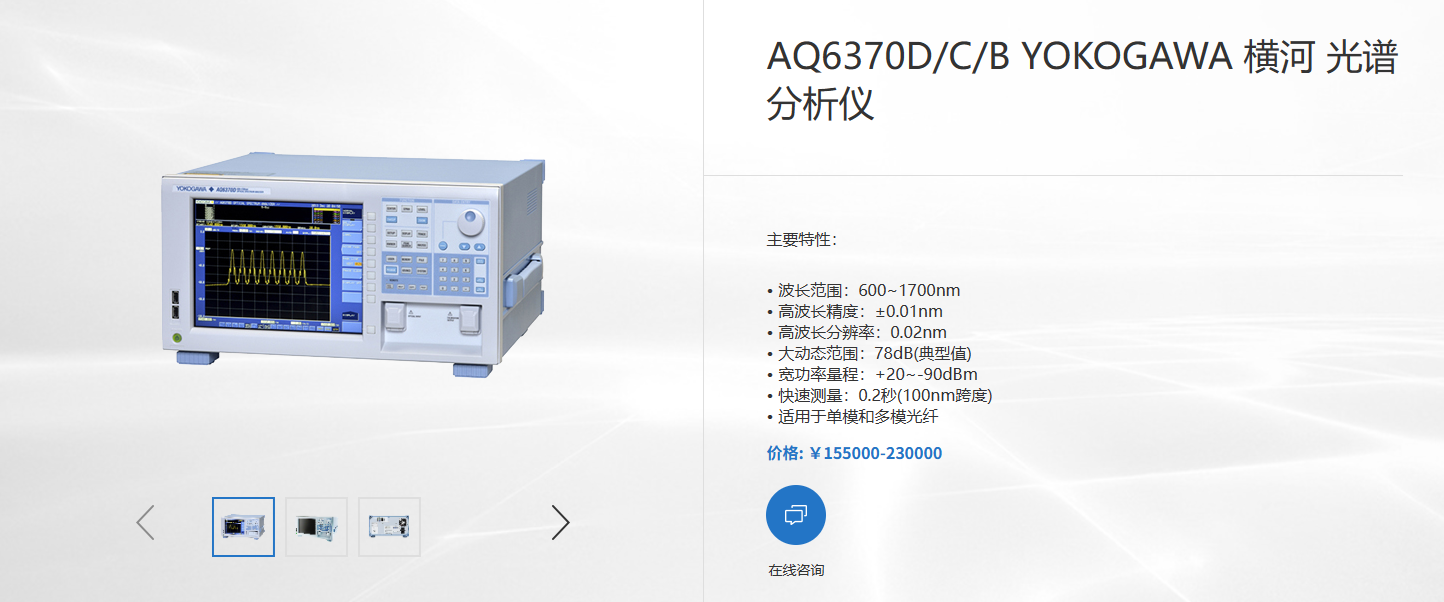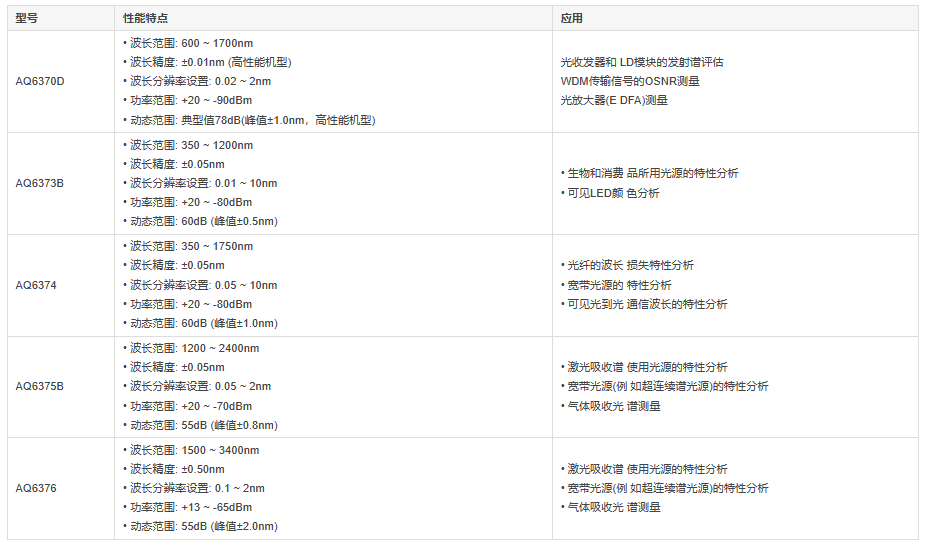AQ6370D Spectrometer FAQ? -How to choose a spectrum analyser?
There is no definite answer to this question because different brands of spectrum analysers may suit different application scenarios and needs. You can choose the most suitable brand according to your budget, measurement target, wavelength range, accuracy requirement and other factors. I can give you some suggestions for reference, but the final decision is still up to you.

Measuring spectral signals in the visible and communication wavelength bands, and with high requirements for wavelength accuracy and stability, then you may want to consider a spectrum analyser from Anritsu. They have a wide range of wavelengths and can cover spectral signals from 400nm to 1700nm. They also have some special features, such as multi-wavelength analysis, polarisation correlation analysis, coherence analysis, etc., which can help you carry out more in-depth spectral research.
Measurement of dense spectral signals, such as DWDM, CWDM, etc., and have high requirements for wavelength resolution and dynamic range, then you can consider Agilent's (Agilent) spectrum analysers. They have high wavelength resolution and dynamic range, which can clearly show the details and differences in the spectral signals. They also have special features such as tunable laser sources, programmable filters, and simultaneous multi-channel measurements that can help you make more flexible and diverse spectral measurements.
Measuring high-precision and complex spectral signals, such as lasers, DWDM, CWDM, etc., and with high requirements for wavelength accuracy, resolution, and dynamic range, then you may want to consider a spectrum analyser from Rohde & Schwarz. They are comparable to the AQ6370D in all of these areas, and also have some special features such as phase noise measurement, modulation depth measurement, and coherence analysis that can help you perform more professional and comprehensive spectrum analysis.
Yokogawa's AQ6370D spectrum analyser is also available. It offers advantages in wavelength range, wavelength resolution, dynamic range, and power range, as well as many new features and improvements, such as data logging, gate sampling, resolution calibration, advanced labelling functions, and enhanced auto-scan mode. It meets your spectral measurement needs in a variety of application scenarios and delivers the most accurate and fastest results.

What are the competitors of Yokogawa AQ6370D Spectrum Analyser?
- Anritsu: etc. The wavelength range of these models is 600~1750nm, the wavelength accuracy is ±0.02nm, the wavelength resolution is 0.03nm, the dynamic range is 58dB (peak ±1nm), and the power range is +20~-80dBm.
- Agilent: 86142B, 86143B, 86146B, etc. These models have a wavelength range of 600~1700nm, wavelength accuracy of ±0.01nm, wavelength resolution of 0.06nm, dynamic range of 60dB (peak ±1nm), and power range of +20~-90dBm. 90dBm.
- Rohde & Schwarz (Rohde & Schwarz): FSW-B1600, FSW-B1601, etc., the wavelength range of these models are 600~1600nm, the wavelength accuracy is ±0.01nm, the wavelength resolution is 0.02nm, the dynamic range is 70dB (peak ±1nm), the power range is +20~-80dB. The dynamic range is 70dB (peak ±1nm), and the power range is +20~-80dBm.
From the above comparison, it can be seen that the AQ6370D has advantages in wavelength resolution, dynamic range and power range, and there are also many new features and improvements, such as data logging, gate sampling, resolution calibration, advanced marking functions and enhanced auto-scan mode.
What are the pros and cons of these spectrum analyser brands?
- Anritsu: The advantage is that the wavelength range is wider, which can cover the visible light and communication bands; the disadvantage is that the wavelength accuracy, resolution and dynamic range are not as good as that of AQ6370D, and there is no data logging and gate sampling.
- Agilent (Agilent): the advantage is that the wavelength accuracy and power range is comparable to the AQ6370D, and there are a variety of measurement modes and analysis functions; the disadvantage is that the wavelength resolution and dynamic range is lower, and the scanning speed is slower.
- Rohde & Schwarz (Rohde & Schwarz): the advantage is that the wavelength accuracy and resolution is comparable to the AQ6370D, and there are high-speed scanning and multi-curve display function; the disadvantage is that the dynamic range is lower, and the power range is narrower.
There is no definite answer to this question because different brands of spectrum analysers may suit different application scenarios and needs. You can choose the most suitable brand according to your budget, measurement target, wavelength range, accuracy requirement and other factors. I can give you some suggestions for reference, but the final decision is still up to you.

Measuring spectral signals in the visible and communication wavelength bands, and with high requirements for wavelength accuracy and stability, then you may want to consider a spectrum analyser from Anritsu. They have a wide range of wavelengths and can cover spectral signals from 400nm to 1700nm. They also have some special features, such as multi-wavelength analysis, polarisation correlation analysis, coherence analysis, etc., which can help you carry out more in-depth spectral research.
Measurement of dense spectral signals, such as DWDM, CWDM, etc., and have high requirements for wavelength resolution and dynamic range, then you can consider Agilent's (Agilent) spectrum analysers. They have high wavelength resolution and dynamic range, which can clearly show the details and differences in the spectral signals. They also have special features such as tunable laser sources, programmable filters, and simultaneous multi-channel measurements that can help you make more flexible and diverse spectral measurements.
Measuring high-precision and complex spectral signals, such as lasers, DWDM, CWDM, etc., and with high requirements for wavelength accuracy, resolution, and dynamic range, then you may want to consider a spectrum analyser from Rohde & Schwarz. They are comparable to the AQ6370D in all of these areas, and also have some special features such as phase noise measurement, modulation depth measurement, and coherence analysis that can help you perform more professional and comprehensive spectrum analysis.
Yokogawa's AQ6370D spectrum analyser is also available. It offers advantages in wavelength range, wavelength resolution, dynamic range, and power range, as well as many new features and improvements, such as data logging, gate sampling, resolution calibration, advanced labelling functions, and enhanced auto-scan mode. It meets your spectral measurement needs in a variety of application scenarios and delivers the most accurate and fastest results.

What are the competitors of Yokogawa AQ6370D Spectrum Analyser?
- Anritsu: etc. The wavelength range of these models is 600~1750nm, the wavelength accuracy is ±0.02nm, the wavelength resolution is 0.03nm, the dynamic range is 58dB (peak ±1nm), and the power range is +20~-80dBm.
- Agilent: 86142B, 86143B, 86146B, etc. These models have a wavelength range of 600~1700nm, wavelength accuracy of ±0.01nm, wavelength resolution of 0.06nm, dynamic range of 60dB (peak ±1nm), and power range of +20~-90dBm. 90dBm.
- Rohde & Schwarz (Rohde & Schwarz): FSW-B1600, FSW-B1601, etc., the wavelength range of these models are 600~1600nm, the wavelength accuracy is ±0.01nm, the wavelength resolution is 0.02nm, the dynamic range is 70dB (peak ±1nm), the power range is +20~-80dB. The dynamic range is 70dB (peak ±1nm), and the power range is +20~-80dBm.
From the above comparison, it can be seen that the AQ6370D has advantages in wavelength resolution, dynamic range and power range, and there are also many new features and improvements, such as data logging, gate sampling, resolution calibration, advanced marking functions and enhanced auto-scan mode.
What are the pros and cons of these spectrum analyser brands?
- Anritsu: The advantage is that the wavelength range is wider, which can cover the visible light and communication bands; the disadvantage is that the wavelength accuracy, resolution and dynamic range are not as good as that of AQ6370D, and there is no data logging and gate sampling.
- Agilent (Agilent): the advantage is that the wavelength accuracy and power range is comparable to the AQ6370D, and there are a variety of measurement modes and analysis functions; the disadvantage is that the wavelength resolution and dynamic range is lower, and the scanning speed is slower.
- Rohde & Schwarz (Rohde & Schwarz): the advantage is that the wavelength accuracy and resolution is comparable to the AQ6370D, and there are high-speed scanning and multi-curve display function; the disadvantage is that the dynamic range is lower, and the power range is narrower.








